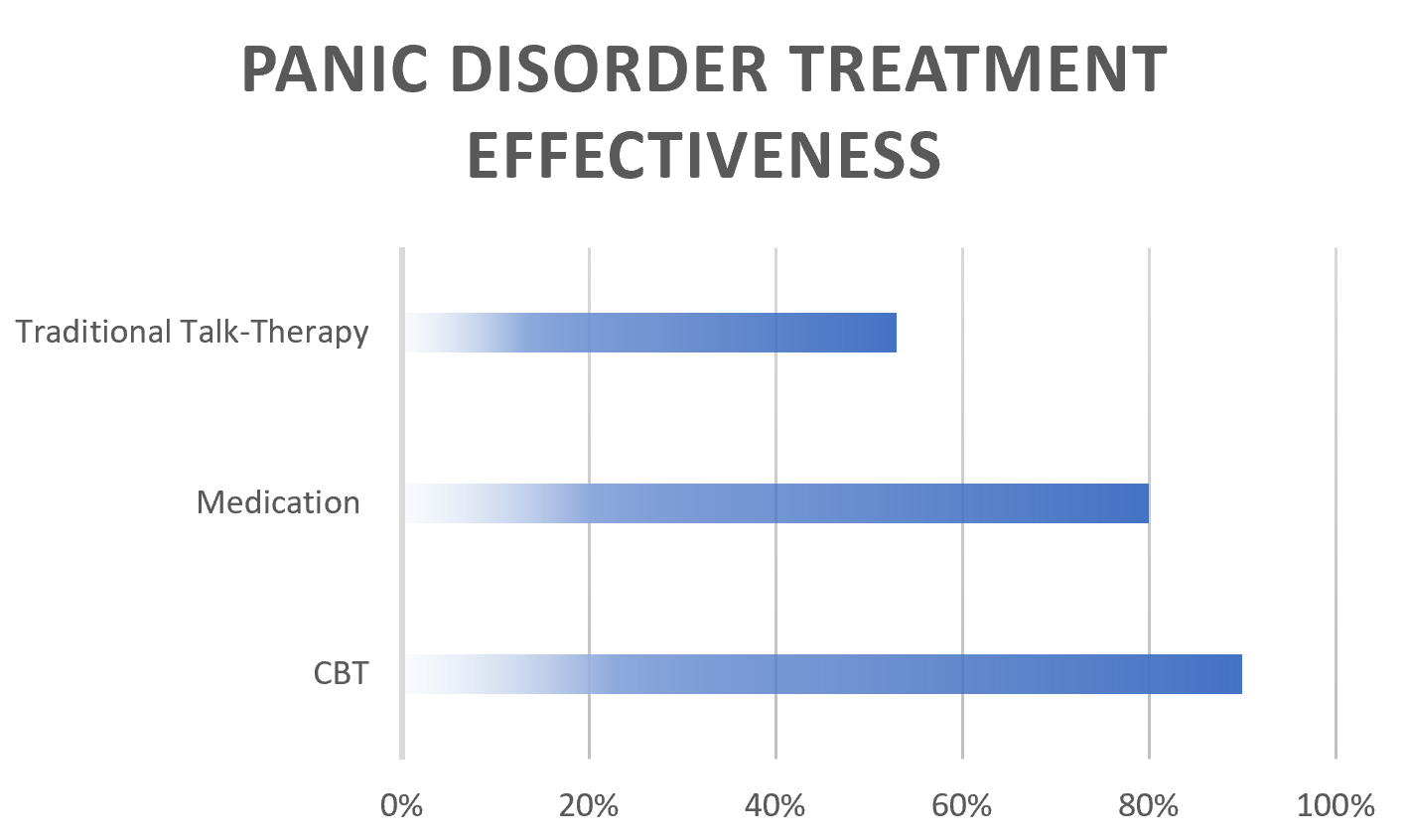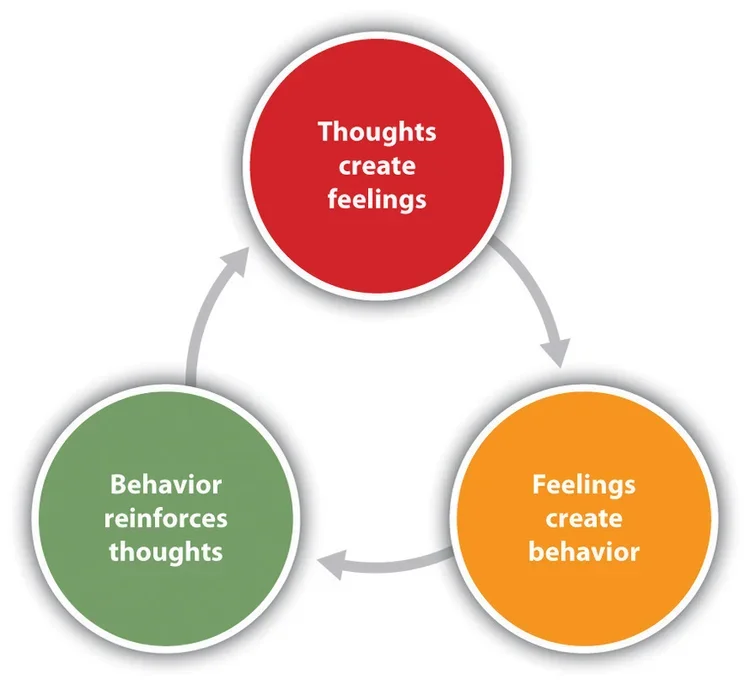Cognitive Behavioral Therapy for Panic Attacks and Panic Disorder
Stop Planning Your Life Around Panic.
Evidence-Based CBT Therapy for Lasting Change
In Weeks. Not Years.
Match with an expert.
Appointments available this week.
When Your Body Hits the Panic Button in the Middle of a Normal Day
You’re in line at Trader Joe’s after work, thinking about dinner and a late Zoom meeting.
Then, without warning, your heart lurches.
It’s suddenly too bright, too loud. Your chest feels tight, your legs feel light, and you have that strange sense of being both there and not there—like the world has been slightly tilted. One thought slices through the noise:
“Something is very wrong. I’m about to lose it—or die—right here in front of everyone.”
You abandon the cart and step outside. Maybe you call a partner or friend. Maybe you sit in your car until your heart rate finally, mercifully, slows down.
The next time you think about going back to that store, you feel a flicker of dread. Maybe you avoid it altogether. One place quietly falls off the map of your life.
If this sounds familiar, you’re not alone, and you’re not “crazy.” These are panic attacks. Over time, the fear of having another one can grow into something bigger: panic disorder, sometimes with agoraphobia, where your world gradually shrinks around the effort to avoid panic.
At Cognitive Behavioral Therapy Los Angeles, this is exactly the kind of pattern we help people untangle. We use structured, evidence-based cognitive behavioral therapy (CBT) for panic attacks and panic disorder, with a clear plan, measurable progress, and practical tools you can use between sessions. We see clients in person in our office and online throughout California.
What Is Cognitive Behavioral Therapy for Panic Attacks and Panic Disorder?
Barlow, D.H., Gorman, J.M., Shear, M.K., & Woods, S.W. (2000).
Cognitive behavioral therapy for panic attacks and panic disorder is a structured, skills-based treatment that helps you change the thoughts, behaviors, and body reactions that keep panic going.
In simple terms, CBT for Panic Disorder usually includes:
Learning how panic works in the body and brain
Identifying and testing catastrophic thoughts about your symptoms
Gradually facing feared sensations and situations
Reducing “safety behaviors” that quietly reinforce fear
Practicing new skills in brief, daily exercises
Panic attacks themselves are intense but time-limited. Cognitive Behavioral Therapy for Panic Attacks is designed to target the cycle that turns a few scary episodes into ongoing dread and avoidance. The goal isn’t just “have fewer attacks.” It’s “feel freer to live the life you want, even if anxiety shows up sometimes.”
Because this is a structured treatment, you’re not guessing whether it’s working. In our practice, we:
Set specific goals together (for example: driving again, flying, going to the gym)
Use brief questionnaires and 0–10 ratings to track panic, avoidance, and quality of life
Check in on your progress every few weeks and adjust the plan if things aren’t moving
Many people start to notice small but meaningful shifts—more understanding, slightly less fear, a bit more freedom—within the first 3–6 weeks, especially when they practice short, focused sessions between sessions. A full course of CBT for Panic Disorder often takes 3-4 months, depending on symptom severity and other factors in your life.
It’s collaborative, transparent, and grounded in research, while still being very human and tailored to you.
Start Feeling Better This Week.
How Panic Attacks Show Up in Real Life
Panic attacks don’t announce themselves with a neat checklist. They arrive in the middle of ordinary moments:
On the freeway, boxed in by cars, noticing your heart pound and thinking, “If I panic here, I’ll lose control.”
In a work meeting, feeling a wave of dizziness and worrying your colleagues will see you shake or forget your words.
At the playground with your kids, suddenly lightheaded and desperate to find a bench where you can “calm down,” all while trying to look normal.
Falling asleep, jolting awake with a racing heart and a sense of unreality, briefly convinced you might be having a heart attack.
On paper, a panic attack is “a sudden episode of intense fear or discomfort,” with symptoms like:
Heart palpitations or pounding heartbeat
Shortness of breath or feeling smothered
Trembling or shaking
Chest pain or discomfort
Dizziness or feeling faint
Sweating, nausea, or chills
Numbness or tingling
Feelings of unreality or being detached
Fears of losing control, going crazy, or dying
The peak usually comes within about ten minutes, and episodes are typically brief. But in the moment, it doesn’t feel brief or benign. It feels urgent and dangerous.
Afterward, something subtle but important often happens: you start rearranging your life around the possibility of the next one.
The Silent Map Your Life Starts Following
If you’ve had more than one panic attack, you might notice how your day starts to organize itself around fear and avoidance:
You choose aisle seats you can easily escape from.
You avoid hot weather, exercise, or caffeine because they mimic panic sensations.
You only drive on familiar routes where you can pull over.
You say no to trips, concerts, elevators, tunnels, or crowded events “just in case.”
You might also develop what CBT calls safety behaviors—subtle things you do to feel safer that, ironically, keep your brain convinced there’s real danger:
Always carrying water, medication, or snacks “so I don’t faint.”
Needing a “safe person” with you in certain places.
Sitting near exits, checking your pulse, or scanning for hospitals.
Using constant distraction (podcasts, scrolling, texting) to avoid noticing your body.
For many people we work with, the pattern sounds like this:
“I used to be able to go anywhere. Now I plan my day around where I might panic. My life looks okay from the outside, but I’m constantly negotiating with my anxiety.”
If you’re recognizing yourself here, you don’t have to wait until you hit some imaginary threshold of “bad enough.” The quieter form of suffering: the canceled plans, the constant scanning, the shrinking map of where you feel safe, is already a valid reason to get support.
And if a part of you worries you’re too far gone because this has been going on for years, you’re not alone there either. Many people come to CBT after trying other approaches and fearing they’re the exception. What we usually find is not that they’re beyond help, but that no one has yet walked them, step by step, through the panic cycle and how to change it.
Panic follows a fairly predictable pattern—and that’s good news, because predictable patterns can be changed.
Why Do Panic Attacks Happen? A CBT View of the Panic Cycle
One of the most powerful moments in treatment is when panic stops feeling like a random lightning strike and starts to look like a loop you can influence.
CBT doesn’t see panic as a character flaw. It sees it as what happens when a very old survival system meets modern life and draws some unhelpful conclusions.
Step 1: Your Body Sets Off the Alarm
The starting point is almost always normal bodily sensations:
Your heart speeds up after climbing stairs.
You feel warm in a crowded room.
You notice a flutter in your chest after a strong coffee.
These are all expressions of the fight-or-flight response, your body’s built-in alarm designed to keep you alive in actual danger. For someone without panic disorder, these sensations are at most mildly annoying.
For someone prone to panic, the sensations are noticed quickly and interpreted as signs that something is seriously wrong. That’s where the loop starts.
Step 2: Catastrophic Thoughts Turn Sensations into an “Emergency”
Here’s where thoughts come in. The body’s normal alarm sensations meet a certain kind of story:
“My heart is pounding; this means I’m going to have a heart attack.”
“I feel unreal; I must be going crazy.”
“I’m dizzy; I’m about to faint and embarrass myself.”
CBT calls these catastrophic misinterpretations, automatic danger stories about what your body is doing. Once that story takes over, anxiety surges. Your heart beats faster. Your breathing gets shallow. You feel more lightheaded, more detached, more shaky… exactly the sensations you’re afraid of.
It becomes a self-reinforcing loop:
Sensation
Catastrophic thought
More anxiety
Stronger sensations
“Proof” that the thought was right
The problem isn’t that your body responds; it’s how your mind explains that response to you.
From an acceptance-and-mindfulness angle, we might say: the sensations themselves are intense, but it’s the story wrapped around them that turns them into an emergency. Part of the work is learning to notice, “Oh, here’s my ‘I’m going to die’ story again,” instead of automatically believing it.
Step 3: Avoidance and Safety Behaviors Cement the Pattern
After a few episodes, another layer appears: anticipatory anxiety, the fear of fear itself. You start scanning for early signs of panic and planning your life to avoid them.
Avoidance and safety behaviors do reduce anxiety in the moment. That’s why they’re so compelling. But they also quietly teach your brain, “That really was dangerous! You only got through it because you escaped or used your backup plan.”
Over time:
Your world shrinks: fewer places and situations feel “safe enough.”
Your confidence shrinks: you trust your own body less and less.
Your identity shifts: from “competent professional/parent/partner” to “someone who has to manage around panic.”
A helpful way to think about it is this: panic isn’t just the 10–15 minutes of intense fear. It’s the entire loop of sensations, interpretations, and avoidance that wraps itself around your life.
The central promise of cognitive behavioral therapy for panic disorder is that if you change how you respond at key points in this loop, the whole pattern can start to soften.
Take the First Step Toward Lasting Relief.
How CBT Helps with Panic Attacks and Panic Disorder
Cognitive Behavioral Therapy for Panic Attacks is essentially a structured way of teaching your brain new rules about your body and the world.
Most CBT approaches for panic combine three broad ingredients:
Psychoeducation – understanding what panic is and what it isn’t
Cognitive work – examining and shifting catastrophic interpretations
Exposure and behavioral experiments – gradually facing feared sensations and situations, while letting go of safety behaviors
Let’s translate that into everyday language.
1. Making Sense of the Panic Alarm
Early sessions usually start with mapping your version of the panic cycle:
What are your most common bodily sensations?
What do you tell yourself they mean?
What do you usually do in response (escape, call someone, sit down, check your pulse)?
Together, you and your therapist put these pieces into a simple, visual model so you can see how physical symptoms, thoughts, and behaviors interact to create full-blown panic and ongoing avoidance.
For many clients, simply understanding that panic is an oversensitive alarm system, not a sign of heart failure or “going crazy,” brings the first real exhale. The sensations are still uncomfortable, but they’re no longer mysterious. They start to make sense.
2. Identifying and Testing Panic Thoughts
Next, CBT invites you to become a kind of scientist of your own mind. You learn to:
Catch and restructure automatic thoughts during or just before panic (“I’m going to collapse”).
Write them down in clear, simple language.
Use structured questions to examine how accurate and how helpful those thoughts really are.
Instead of “My heart is pounding, so I must be having a heart attack,” you might eventually land on something more balanced, like:
“My heart is pounding because my fight-or-flight system flipped on. This has happened many times before, and it has always come down.”
Alongside classic cognitive restructuring, we often add a mindfulness twist: noticing thoughts as mental events rather than facts. You might practice phrases like, “I’m noticing my ‘danger’ thought again,” and bring your attention back to your breath or your surroundings, rather than diving deeper into the story.
This isn’t forced positive thinking. It’s more accurate thinking, paired with a different relationship to your thoughts. Over time, these more balanced interpretations start to show up in real time, not just in your therapy notes. That gives the panic cycle fewer chances to spiral.
Facing Fear on Purpose: Exposure and Behavioral Experiments
If cognitive work is about changing the story in your mind, exposure is about giving your body new experiences to learn from.
This is the part many people fear most at first, and, later, describe as the part that changed everything.
What Exposure Actually Means (and What It Doesn’t)
In Cognitive Behavioral Therapy for Panic Attacks, exposure means gradually and intentionally approaching the sensations and situations you’ve been avoiding, in a planned way, with support.
It does not mean being thrown into your worst nightmare on day one.
Together with your therapist, you build a fear ladder or exposure hierarchy, a list of situations and sensations, from “annoying but doable” to “this scares me a lot.” You start near the bottom, at a level that is uncomfortable but not overwhelming, and move up as your confidence grows.
There are two main types:
Interoceptive exposure – deliberately bringing on feared bodily sensations
Spinning in a chair to feel dizzy
Running in place or stepping up and down to increase heart rate
Breathing through a narrow straw to feel short of breath
Situational exposure – re-entering avoided situations
Driving on the freeway again
Riding elevators, planes, or public transportation
Sitting in the middle of a crowded theater or restaurant
Going back to the grocery store you abandoned mid-panic
A typical exposure task might look like this:
Plan the experiment. For example: “Drive on the freeway for one exit without using my usual safety behaviors.”
Make predictions. You rate how anxious you expect to feel (0–10) and what you fear will happen (“I’ll lose control and crash”).
Do the exposure. You stay with the sensations long enough for your body to gather new data, using skills you’ve practiced in session.
Rate and reflect. You record what actually happened—your real anxiety level, how long it lasted, what you did that helped.
Repeat. You run the same experiment several times until the situation feels more familiar and less dangerous.
This is how your brain learns:
“My heart can pound without anything terrible happening.”
“I can feel dizzy and stay standing.”
“I can be anxious in a meeting and still function.”
Instead of letting panic call the shots, you repeatedly teach your nervous system, “This is uncomfortable, but it isn’t an emergency.”
“Won’t Exposure Just Make Me Worse?”
This is one of the most common worries people bring to us.
If your past experience was being overwhelmed by anxiety with no clear plan, it makes sense that “facing fear” sounds risky. In CBT for Panic Disorder, exposure is:
Collaborative: You and your therapist agree on every step. Nothing is a surprise.
Graded: You start with smaller challenges, not the hardest thing on your list.
Skill-supported: You already have tools (breathing, grounding, cognitive strategies) before you try the tougher tasks.
Measured: You track your anxiety levels and progress over time, so you can see patterns rather than guessing.
Exposure is not about suffering for its own sake. It’s about conducting carefully designed experiments that test what anxiety has been telling you.
Behavioral Experiments: Testing Anxiety’s Story
Sometimes the most helpful frame is: “Let’s see what happens.”
Instead of assuming “If I let my heart race, I’ll faint,” you and your therapist design a behavioral experiment:
Hypothesis: “If my heart rate goes up to an 8/10, I will faint.”
Experiment: Jog in place in the office or at home until your heart is racing, then stand still and observe.
Result: You feel intense sensations, but you don’t faint. The discomfort peaks and then gradually settles.
Each experiment slightly loosens anxiety’s grip. You’re no longer arguing with your thoughts in the abstract; you’re gathering real-world evidence.
In ACT-informed CBT, we pair this with a shift in stance: instead of “I must eliminate all anxiety,” the question becomes, “Can I make room for some anxiety while I do what matters to me?” That’s a very different way of living.
Book Now. Same-Week Sessions Available Now.
What CBT for Panic Looks Like Week to Week in Our Practice
People are often relieved to hear that CBT for panic is not an endless, vague process. It’s structured, time-limited, and focused on skills you can carry forward.
At our practice, a typical course of Cognitive Behavioral Therapy for Panic Disorder might look like this:
Early Sessions: Mapping, Goals, and First Tools
In the first few 50-minute sessions, you and your therapist focus on:
Your history with anxiety and panic (what you’ve tried, what helped, what didn’t)
Your main triggers, avoidance patterns, and safety behaviors
Establishing clear, concrete goals (for example: “Drive to work on the freeway again,” “Fly to visit family,” “Exercise without fearing my heart rate”)
Introducing the CBT model of the panic cycle in a way that makes sense to you
We often start by:
Using brief questionnaires and 0–10 scales to get a baseline for panic frequency, intensity, and avoidance
Drawing a simple map of your panic loop: sensations → interpretations → actions
Giving you 1–2 small home practices, like tracking panic episodes or noticing automatic thoughts
By the end of this phase, you have language for what’s happening and a rough outline of where treatment is headed. Many clients describe this as the first time their panic has ever “made sense.”
Middle Phase: Practice, Adjustment, and Real-Life Wins
As you move into the middle of treatment, sessions become more active and experiential. You might:
Practice interoceptive exposure in session, with your therapist coaching you through staying with sensations
Plan and review situational exposures you’re doing between sessions
Refine thought records and mindfulness skills to use in the moment
Identify safety behaviors to gradually reduce (like always carrying a bottle of water or sitting by the door)
Throughout this phase, we keep tracking your panic and avoidance levels using simple ratings and occasional questionnaires. Around weeks 4–6, we step back together and ask:
Are your scores starting to shift?
Are you doing things you hadn’t done in a while, even if you still feel anxious?
Where are things stuck?
If we see progress, we build on it. If things aren’t moving as expected, we adjust the plan. Perhaps adding different exposures, focusing more on certain thoughts, or integrating more acceptance and values work.
You’re not passively hoping therapy works; you’re an active partner in tweaking the process.
Integrating Mindfulness and Acceptance
Along the way, we weave in mindfulness and acceptance-based tools to help you change your relationship with anxiety itself:
Brief grounding practices you can use anywhere (for example, feeling your feet on the floor, naming five things you see)
Noticing thoughts as “mental events” rather than facts (“I’m having the thought that I’m going to die”)
Practicing staying with waves of sensation—heart pounding, dizziness, warmth—without immediately trying to fix or escape them
The aim isn’t to become a perfectly calm person. It’s to be someone who can feel anxiety and still drive, parent, present, travel, and show up in the ways that matter to you.
Get a Personalized Plan Today.
Common Fears and Objections About Starting Therapy for Panic
By the time someone reaches out to us, they’re often carrying two sets of fears:
The fear of panic itself.
The fear of making the “wrong move” with treatment: wasting time or money, or being pushed too hard.
It helps to name some of these out loud.
“What if my problem isn’t ‘bad enough’ for therapy?”
Panic has a way of making you feel like you’re both “too much” and “not enough.” You might think:
“Other people have it worse. I can still function.”
“Maybe I should just handle this on my own.”
In CBT, the question isn’t whether your suffering qualifies on some external scale. It’s simpler:
Is panic affecting your choices, relationships, or work?
Are you organizing your life around avoiding panic?
Are you tired of negotiating with your own nervous system?
If yes, then it’s “enough” to deserve care. You don’t have to wait for everything to fall apart to get help.
“What if I’m the one person CBT can’t help?”
On the other side, some people worry they’re beyond help:
“I’ve been dealing with this for years.”
“I’ve tried therapy or self-help before, and it didn’t stick.”
We’re careful not to promise miracles. But panic and panic disorder are problems CBT was specifically designed to treat. The fact that previous approaches haven’t worked often says more about the fit than about you.
CBT for panic offers things some other approaches don’t: a clear model, specific exposure plans, measurable progress, and willingness to adjust the plan if you’re not improving.
“I’m worried about the time and cost… and wasting both.”
This is a practical and valid concern.
Cognitive Behavioral Therapy for Panic Disorder tries to respect your investment by being:
Goal-oriented: You and your therapist agree on what you’re working toward.
Transparent: You know what you’re doing in session and why.
Time-aware: We’re looking for concrete movement, especially in the first 3–6 weeks.
Skills-focused: You’re learning strategies you can continue to use on your own.
A free 15-minute consultation can help you think this through. You can ask about frequency, likely length of treatment, and what home practice would look like. Even if you decide not to move forward, you’ll leave with a clearer sense of what effective CBT for panic involves.
“Will my therapist judge me or push me faster than I can handle?”
Good CBT is collaborative, not coercive.
Your therapist brings expertise in anxiety and panic. You bring expertise in you. Your values, limits, and lived experience. The work only moves at the intersection of both.
We expect you to have mixed feelings, to be scared of certain exercises, and to need to negotiate pace. That’s not a flaw; that’s part of the process we plan for.
See How CBT Can Work For You.
FAQ: Cognitive Behavioral Therapy for Panic Attacks and Panic Disorder
What is CBT for panic attacks in simple terms?
CBT for panic attacks is a structured form of therapy that helps you understand how your thoughts, body sensations, and behaviors interact to create panic, and then systematically change those patterns. It combines education, cognitive tools, exposure, and daily practice so you can feel less controlled by fear and more able to live your life.
Why do I keep having panic attacks when nothing dangerous is happening?
You keep having panic attacks because your body’s alarm system has become overly sensitive and your mind is interpreting normal sensations as signs of catastrophe. Once you start fearing the sensations themselves, you can trigger the fight-or-flight response without any real external danger. CBT helps you retrain that alarm system and change how you respond to early warning signs.
How long does CBT for panic usually take to work?
Many people notice some relief or increased understanding within the first few weeks, especially as they learn how panic works and start using basic tools. A full course of Cognitive Behavioral Therapy for Panic Disorder often takes a few months, depending on how severe the symptoms are, how consistently you practice between sessions, and whether there are other issues (like depression or other anxiety problems) happening at the same time.
When should I seek professional help for panic attacks?
It’s a good idea to seek help when panic attacks are:
Causing you to avoid places, activities, or responsibilities
Making everyday tasks (like driving, shopping, or social events) feel difficult
Leaving you preoccupied with worries about your health or “going crazy”
Taking up significant time and mental energy
You don’t need to wait for a crisis. Getting support earlier can make it easier to keep your life from shrinking around panic.
Can CBT help if I’m already taking medication? Or if I don’t want medication?
Yes. Many people benefit from CBT whether or not they take medication. Some use therapy alongside medication prescribed by a physician; others prefer to focus on psychological tools first. CBT can support either path by giving you skills and a clearer understanding of what’s happening in your body and mind. Any decisions about medication are made with a medical provider; therapy can help you think through the options.
Is online CBT for panic attacks effective?
For most people, online CBT for panic attacks can be just as effective as in-person work. The key ingredients—education, cognitive tools, exposure planning, and between-session practice—translate well to secure video sessions. Some exposures can even be done in your real-life settings while you’re on a call with your therapist.
Taking the Next Step
If you live with panic, you’re already doing something hard every day: carrying an invisible fear that the next attack could happen at any moment.
Therapy doesn’t erase that history. But it can give you:
A clear map of what’s been happening
Practical tools to respond differently
A way to measure whether things are actually improving
A space where you don’t have to downplay or hide what you’re going through
At Cognitive Behavioral Therapy Los Angeles, we work with adults who are tired of organizing their lives around anxiety and want a structured, evidence-based path forward. Some come with one specific goal: flying again, commuting by train, or going to their child’s events. Others want to change a whole pattern of avoidance that’s been shaping their life for years.
If you recognize yourself in this description, your next step doesn’t have to be huge. It might be:
Scheduling a free 15-minute consultation to talk through your situation, ask questions, and get a sense of whether CBT for Panic Disorder feels like a good fit
Or, if you’re feeling ready, booking a full first appointment to start building your plan
It’s okay if you’re ambivalent or nervous. You don’t have to have the perfect words or a fully formed story. Your first contact is simply a conversation about what you’re dealing with and what options you have.
Panic has been telling you a story about what you can and can’t handle. Cognitive Behavioral Therapy for Panic Attacks gives you a chance to test that story carefully, collaboratively, and with real data, and often to discover that you’re more capable, and your world more expandable, than anxiety has led you to believe.
Begin Your Path To a Life Of Calm Confidence.
Medically Reviewed by Albert Bonfil, PsyD
Barlow, D.H., Gorman, J.M., Shear, M.K., & Woods, S.W. (2000). Cognitive-behavioral therapy, imipramine, or their combination for panic disorder: A randomized controlled trial. Journal of the American Medical Association, 283, 19, 2529-2536.










